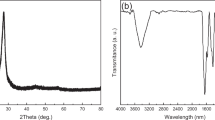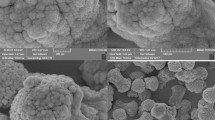Abstract
In this research work, CuS and WO3 nanoparticles were synthesized by a simple, facile and effective hydrothermal method followed by the fabrication of nanocomposites of 10, 12 & 14% CuS:WO3. The prepared samples were characterized by various characterization techniques including X-ray diffraction (XRD), UV–Visible (UV–vis), photoluminescence (PL), Energy dispersive X-ray (EDX) and field emission scanning electron microscopy (FE-SEM) for the confirmation and investigation of fabricated nanocomposites. The particle size of fabricated WO3 was 46.01 nm which was reduced to 37.14 nm for 14% CuS:WO3 sample. Additionally, UV visible and PL analysis confirmed the suppression of band gap (2.61 to 2.25 eV) and photogenerated electron/hole pair respectively. Photocatalytic activity of as prepared nanocomposites was investigated under visible light irradiation against rhodamine B (RhB) dye. Quite interestingly, the photodegradation efficiency of 14% CuS-WO3 is 94.91% which is much higher as compared to pure WO3 which attributes to the smaller particle size and bad gap energy which enables the efficient utilization of visible light leading to the generation of reactive species. Reusability experiments confirmed the photostability of samples and pH tests have also been conducted to investigate the optimum pH for degradation reaction. For investigation of complete mineralization of RhB dye from contaminated water, TOC analysis has been conducted. Additionally, RF module of COMOSL Multiphysics 5.3a has been used to simulate a 2D model to correlated the experiment with the theoretical results for better understanding.
Graphical Abstract












Similar content being viewed by others
Data Availability
All data generated or analyzed during this study are included in this published article
References
A.A. Shah, A.D. Chandio, A.A. Sheikh, Boron doped ZnO nanostructures for photo degradation of methylene blue, methyl orange and rhodamine B. J. Nanosci. Nanotechnol. 21(4), 2483–2494 (2021)
M.B. Tahir et al., WO3 nanostructures-based photocatalyst approach towards degradation of RhB dye. J. Inorg. Organomet. Polym Mater. 28(3), 1107–1113 (2018)
V. Dutta et al., An overview on WO3 based photocatalyst for environmental remediation. J. Environ. Chem. Eng. 9(1), 105018 (2021)
R. Ameta et al., Photocatalysis, in Advanced oxidation processes for waste water treatment. (Elsevier, Amsterdam, 2018), pp.135–175
C. Tanielian, Decatungstate photocatalysis. Coord. Chem. Rev. 178, 1165–1181 (1998)
B. Chen et al., Preparation of MoS2/TiO2 based nanocomposites for photocatalysis and rechargeable batteries: progress, challenges, and perspective. Nanoscale 10(1), 34–68 (2018)
M.A. Bhatti et al., Effective removal of methylene blue by surface alteration of TiO2 with Ficus Carica leaf extract under visible light. Nanomaterials 12(16), 2766 (2022)
M.A. Bhatti et al., Low temperature aqueous chemical growth method for the doping of W into ZnO nanostructures and their photocatalytic role in the degradration of methylene blue. J. Clust. Sci. (2022). https://doi.org/10.1007/s10876-021-02069-6
Y. Liu et al., One-step synthesis of a WO3-CuS nanosheet heterojunction with enhanced photocatalytic performance for methylene blue degradation and Cr (VI) reduction. J. Chem. Technol. Biotechnol. 95(3), 665–674 (2020)
M. Sohaib et al., Novel sol–gel synthesis of Mo-doped ZnO-NPs for photo-catalytic waste water treatment using the RhB dye as a model pollutant. Environ. Develop. Sustain. (2022). https://doi.org/10.1007/s10668-022-02543-9
Z.A. Ujjan et al., Simultaneous doping of sulfur and chloride ions into ZnO nanorods for improved photocatalytic properties towards degradation of methylene blue. Ceram. Int. 48(4), 5535–5545 (2022)
M.G. Peleyeju, E.L. Viljoen, WO3-based catalysts for photocatalytic and photoelectrocatalytic removal of organic pollutants from water–A review. J. Water Process Eng. 40, 101930 (2021)
A. Mehta et al., Band gap tuning and surface modification of carbon dots for sustainable environmental remediation and photocatalytic hydrogen production–A review. J. Environ. Manage. 250, 109486 (2019)
M.A. Bhatti et al., Efficient photo catalysts based on silver doped ZnO nanorods for the photo degradation of methyl orange. Ceram. Int. 45(17), 23289–23297 (2019)
C.D. SONG et al., Synthesis direct Z-scheme CuS-WO3 photocatalysts based on an element-reaction route and their photocatalytic activity. Acta Phys. Chim. Sin. 33(9), 1891–1897 (2017)
D. Rohilla et al., Microwave mediated synthesis of dopamine functionalized copper sulphide nanoparticles: an effective catalyst for visible light driven degradation of methlyene blue dye. Chemosphere 277, 130202 (2021)
F. Siddique et al., Effect of surface modification and H2 reduction of WO3 nanoparticles in methylene blue photodegradation. Surf. Topogr. Metrol. Prop. 8(4), 045012 (2020)
T. Iqbal, M. Ashraf, A. Masood, Simple synthesis of WO3 based activated carbon co-doped CuS composites for photocatalytic applications. Inorg. Chem. Commun. 139, 109322 (2022)
C. Song et al., Enhanced performance of direct Z-scheme CuS-WO3 system towards photocatalytic decomposition of organic pollutants under visible light. Appl. Surf. Sci. 425, 788–795 (2017)
J. Khatter, R. Chauhan, Visible light-motivated photo-catalytic activity of CdS–Cu9S5 heterostructure for degradation of methylene blue. Appl. Nanosci. 12(5), 1683–1696 (2022)
Y. Vyas et al., Biosynthesis and characterization of carbon quantum Dots@ CuS composite using water hyacinth leaves and its usage in photocatalytic dilapidation of brilliant green dye. Mater. Chem. Phys. 281, 125921 (2022)
F. Peng et al., Gas sensing performance and mechanism of CuO (p)-WO3 (n) composites to H2S gas. Nanomaterials 10(6), 1162 (2020)
A. Malathi, J. Madhavan, Synthesis and characterization of CuS/CdS photocatalyst with enhanced visible light-photocatalytic activity. J. Nano Res. (2017). https://doi.org/10.4028/www.scientific.net/JNanoR.48.49
J. Han et al., Mesoporous TiO2 with WO3 functioning as dopant and light-sensitizer: a highly efficient photocatalyst for degradation of organic compound. J. Hazard. Mater. 358, 44–52 (2018)
P.S. Kumar, P.T. Ngueagni, A review on new aspects of lipopeptide biosurfactant: types, production, properties and its application in the bioremediation process. J. Hazard. Mater. 407, 124827 (2021)
H. Song et al., Synthesis of Fe-doped WO3 nanostructures with high visible-light-driven photocatalytic activities. Appl. Catal. B 166, 112–120 (2015)
F. Stirling et al., Synthetic cassettes for pH-mediated sensing, counting, and containment. Cell Rep. (2020). https://doi.org/10.1016/j.celrep.2020.02.033
N.L. da Costa et al., Phosphotungstic acid on activated carbon: a remarkable catalyst for 5-hydroxymethylfurfural production. Mol. Catal. 500, 111334 (2021)
X. Zhang et al., Construction of core-shell structured WO3@ SnS2 hetero-junction as a direct Z-scheme photo-catalyst. J. Colloid Interface Sci. 554, 229–238 (2019)
M. He et al., Highly sensitive and selective H2S gas sensors based on flower-like WO3/CuO composites operating at low/room temperature. J. Alloy. Compd. 788, 36–43 (2019)
C. Wang et al., Preparation of Pd/PdO loaded WO3 microspheres for H2S detection. Sens. Actuators, B Chem. 321, 128629 (2020)
H.-M. Lin et al., Nanocrystalline WO3-based H2S sensors. Sens. Actuators, B Chem. 22(1), 63–68 (1994)
M. Punginsang et al., Selective H2S gas sensors based on ohmic hetero-interface of Au-functionalized WO3 nanowires. Appl. Surf. Sci. 571, 151262 (2022)
B. Subash et al., Highly efficient, solar active, and reusable photocatalyst: Zr-loaded Ag–ZnO for reactive red 120 dye degradation with synergistic effect and dye-sensitized mechanism. Langmuir 29(3), 939–949 (2013)
S. Kabcum et al., Ultra-responsive hydrogen gas sensors based on PdO nanoparticle-decorated WO3 nanorods synthesized by precipitation and impregnation methods. Sens. Actuators, B Chem. 226, 76–89 (2016)
Y. Zhang, J. Chang, Y. Wang, Mechanism analysis of PtPd-decorated hexagonal WO3 nanorods for H2S sensing application with ppt-level detection limit. J. Alloy. Compd. 892, 162133 (2022)
A. Houas et al., Photocatalytic degradation pathway of methylene blue in water. Appl. Catal. B 31(2), 145–157 (2001)
C.H. Kwon et al., Degradation of methylene blue via photocatalysis of titanium dioxide. Mater. Chem. Phys. 86(1), 78–82 (2004)
S. Lakshmi, R. Renganathan, S. Fujita, Study on TiO2-mediated photocatalytic degradation of methylene blue. J. Photochem. Photobiol., A 88(2–3), 163–167 (1995)
Acknowledgements
The Authors would like to thank Scientific Research Deanship at Ha’il University- Saudi Arabia for financial support of this project through Project Number RG-20119.
Funding
Scientific Research Deanship at Ha’il University- Saudi Arabia,RG-20119
Author information
Authors and Affiliations
Contributions
MA contributed towards conceptualization, methodology and initial draft. TI contributed in formal analysis, supervision and review of final draft whereas AM, NM, FIAA, WIE-S and SMM contributed for experimental investigation, formal analysis and validation. MA and MSM contributed for review and editing of final draft.
Corresponding authors
Ethics declarations
Competing interests
The Authors would like to thank Scientific Research Deanship at Ha’il University- Saudi Arabia for financial support of this project through Project Number RG-20119
Ethical Approval
Not applicable.
Consent to Participate
Not applicable.
Consent to Publish
Not applicable.
Additional information
Publisher's Note
Springer Nature remains neutral with regard to jurisdictional claims in published maps and institutional affiliations.
Rights and permissions
Springer Nature or its licensor (e.g. a society or other partner) holds exclusive rights to this article under a publishing agreement with the author(s) or other rightsholder(s); author self-archiving of the accepted manuscript version of this article is solely governed by the terms of such publishing agreement and applicable law.
About this article
Cite this article
Ashraf, M., Iqbal, T., Masood, A. et al. Experimental and Theoretical Verification of WO3 Based Nanocomposites for Their Application as Efficient Photo Catalyst for Treatment of Industrial Wastewater. J Inorg Organomet Polym 33, 2537–2551 (2023). https://doi.org/10.1007/s10904-023-02705-w
Received:
Accepted:
Published:
Issue Date:
DOI: https://doi.org/10.1007/s10904-023-02705-w




